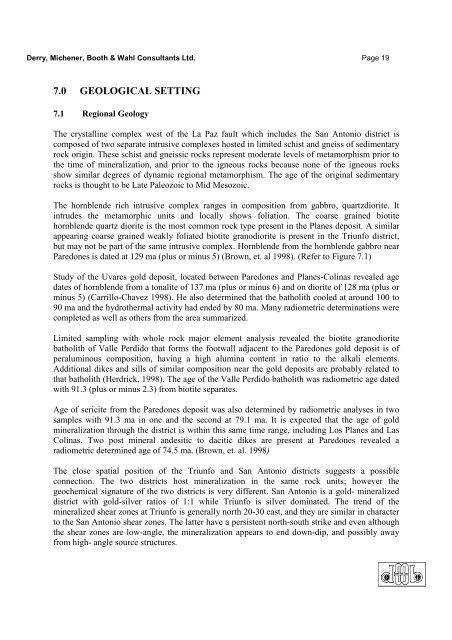43-101 2007 Technical Report On The San Antonio Project, Baja ...
43-101 2007 Technical Report On The San Antonio Project, Baja ...
43-101 2007 Technical Report On The San Antonio Project, Baja ...
Create successful ePaper yourself
Turn your PDF publications into a flip-book with our unique Google optimized e-Paper software.
Derry, Michener, Booth & Wahl Consultants Ltd. Page 197.0 GEOLOGICAL SETTING7.1 Regional Geology<strong>The</strong> crystalline complex west of the La Paz fault which includes the <strong>San</strong> <strong>Antonio</strong> district iscomposed of two separate intrusive complexes hosted in limited schist and gneiss of sedimentaryrock origin. <strong>The</strong>se schist and gneissic rocks represent moderate levels of metamorphism prior tothe time of mineralization, and prior to the igneous rocks because none of the igneous rocksshow similar degrees of dynamic regional metamorphism. <strong>The</strong> age of the original sedimentaryrocks is thought to be Late Paleozoic to Mid Mesozoic.<strong>The</strong> hornblende rich intrusive complex ranges in composition from gabbro, quartzdiorite. Itintrudes the metamorphic units and locally shows foliation. <strong>The</strong> coarse grained biotitehornblende quartz diorite is the most common rock type present in the Planes deposit. A similarappearing coarse grained weakly foliated biotite granodiorite is present in the Triunfo district,but may not be part of the same intrusive complex. Hornblende from the hornblende gabbro nearParedones is dated at 129 ma (plus or minus 5) (Brown, et. al 1998). (Refer to Figure 7.1)Study of the Uvares gold deposit, located between Paredones and Planes-Colinas revealed agedates of hornblende from a tonalite of 137 ma (plus or minus 6) and on diorite of 128 ma (plus orminus 5) (Carrillo-Chavez 1998). He also determined that the batholith cooled at around 100 to90 ma and the hydrothermal activity had ended by 80 ma. Many radiometric determinations werecompleted as well as others from the area summarized.Limited sampling with whole rock major element analysis revealed the biotite granodioritebatholith of Valle Perdido that forms the footwall adjacent to the Paredones gold deposit is ofperaluminous composition, having a high alumina content in ratio to the alkali elements.Additional dikes and sills of similar composition near the gold deposits are probably related tothat batholith (Herdrick, 1998). <strong>The</strong> age of the Valle Perdido batholith was radiometric age datedwith 91.3 (plus or minus 2.3) from biotite separates.Age of sericite from the Paredones deposit was also determined by radiometric analyses in twosamples with 91.3 ma in one and the second at 79.1 ma. It is expected that the age of goldmineralization through the district is within this same time range, including Los Planes and LasColinas. Two post mineral andesitic to dacitic dikes are present at Paredones revealed aradiometric determined age of 74.5 ma. (Brown, et. al. 1998)<strong>The</strong> close spatial position of the Triunfo and <strong>San</strong> <strong>Antonio</strong> districts suggests a possibleconnection. <strong>The</strong> two districts host mineralization in the same rock units; however thegeochemical signature of the two districts is very different. <strong>San</strong> <strong>Antonio</strong> is a gold- mineralizeddistrict with gold-silver ratios of 1:1 while Triunfo is silver dominated. <strong>The</strong> trend of themineralized shear zones at Triunfo is generally north 20-30 east, and they are similar in characterto the <strong>San</strong> <strong>Antonio</strong> shear zones. <strong>The</strong> latter have a persistent north-south strike and even althoughthe shear zones are low-angle, the mineralization appears to end down-dip, and possibly awayfrom high- angle source structures.











